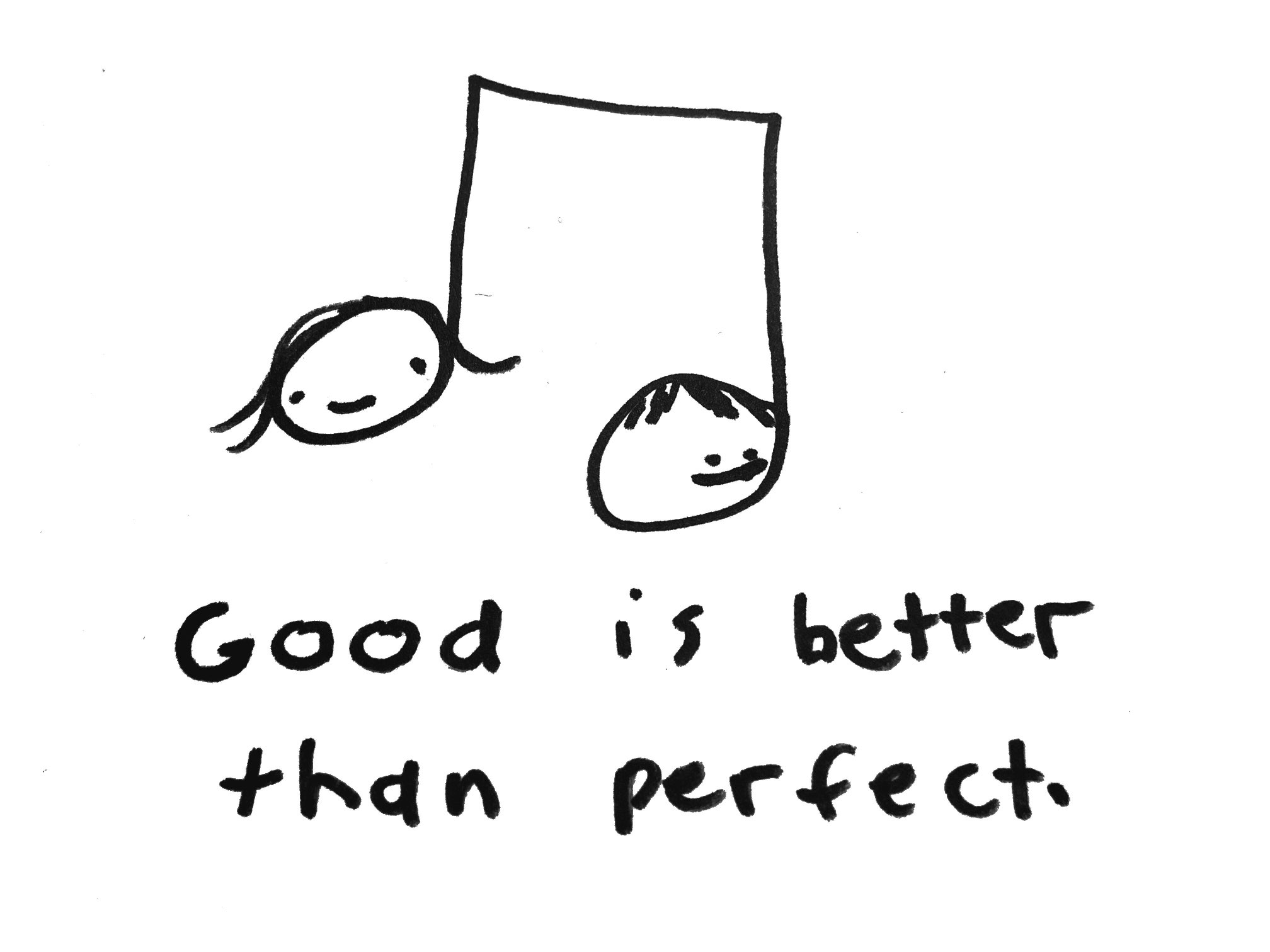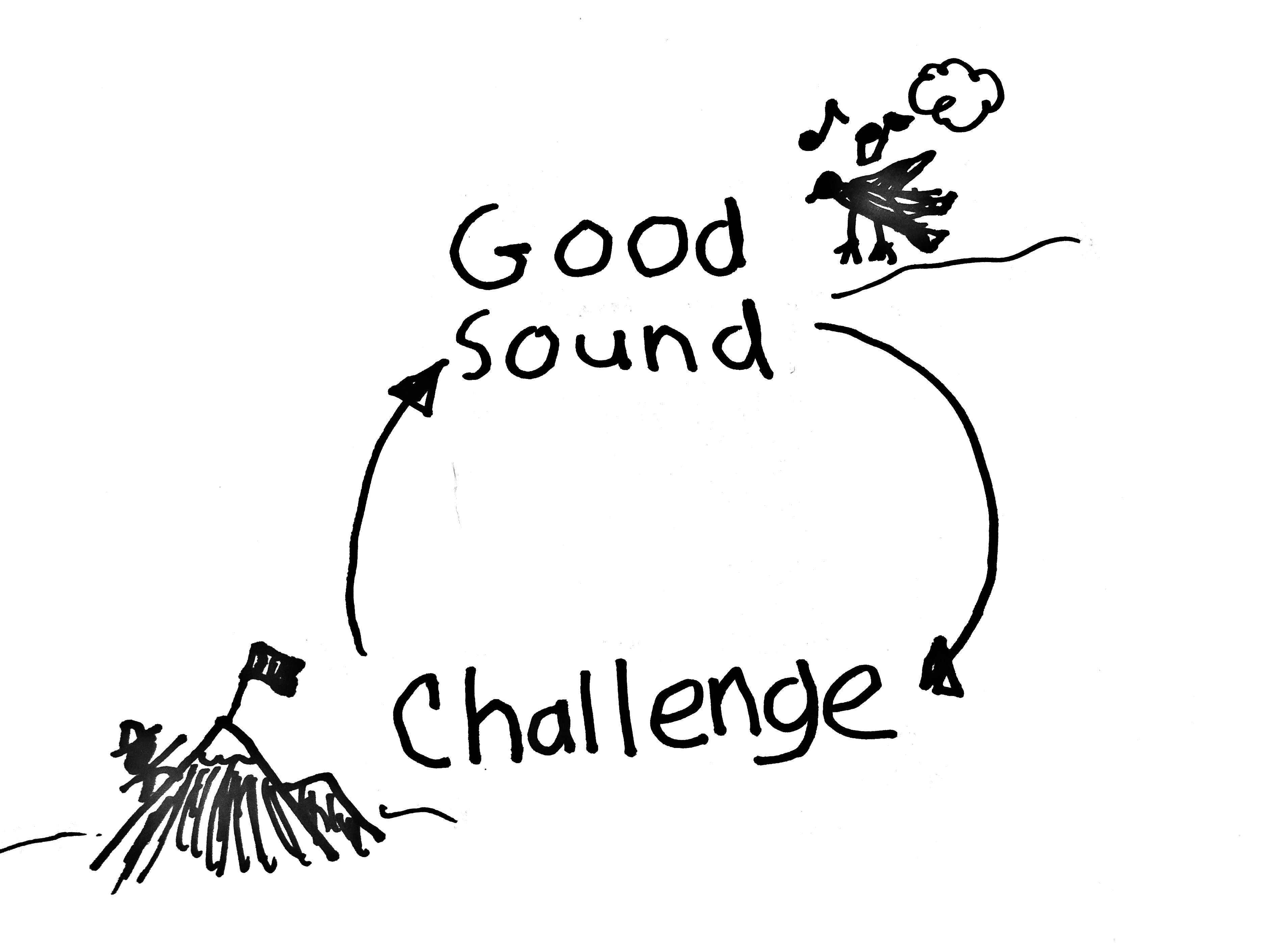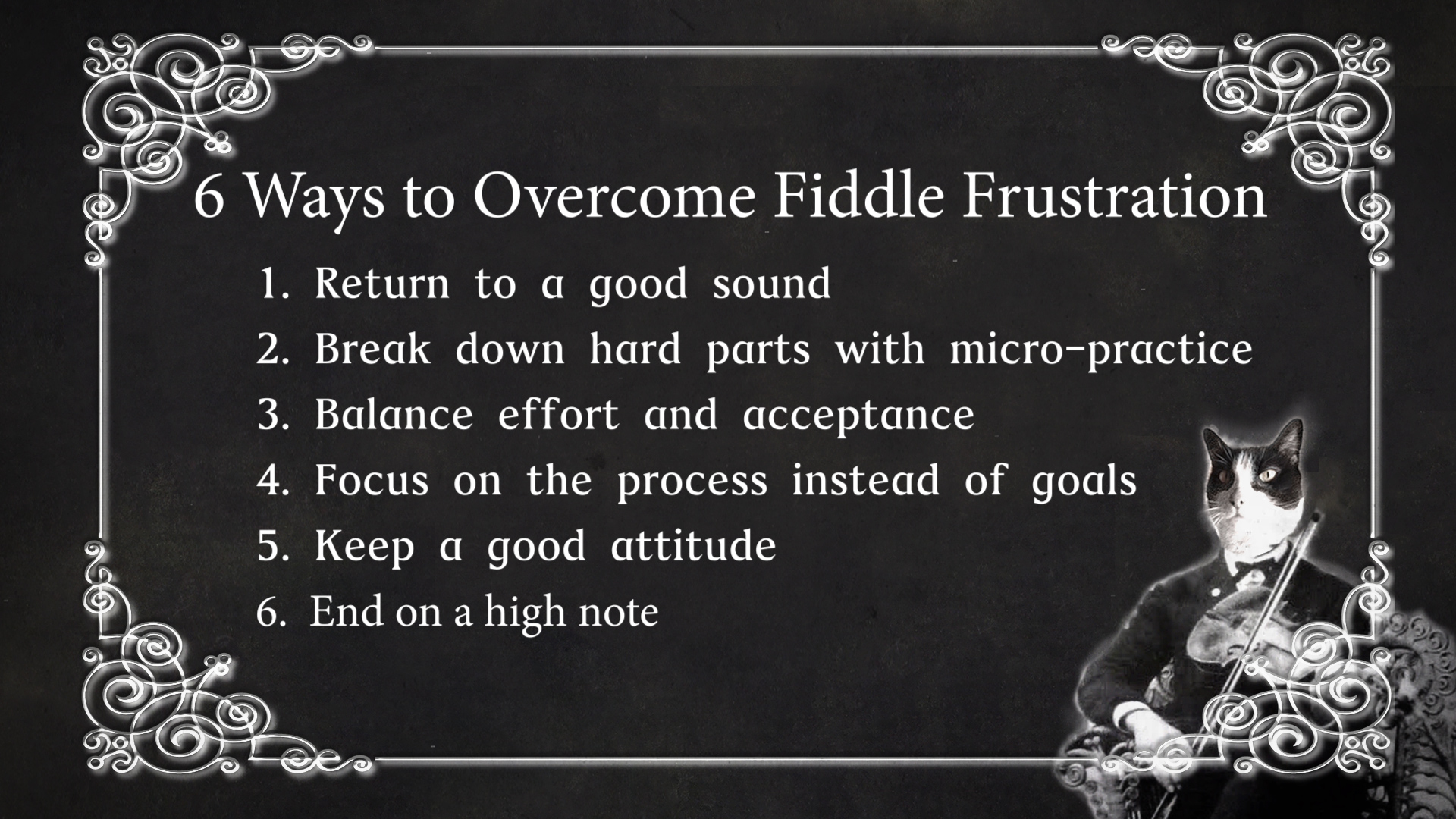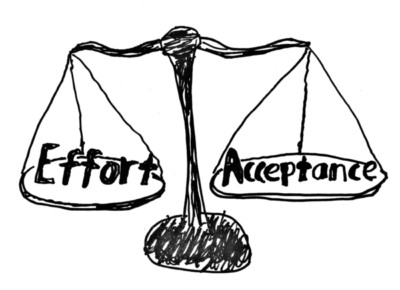A lot of you have told me that you’re frustrated because your current level of playing is nowhere near where you want to be.
You want to be ripping mind-crunching solos like Mark O’Connor. But it seems like you’ll never get there.
In this Fiddlosophy post, I’m going to suggest six ways to overcome fiddle frustration. I want you to be happily learning and playing the fiddle every day. Here are the main points:
- Return to a good sound
- Break down hard parts with micro-practice
- Balance effort and acceptance
- Focus on the daily process instead of goals
- Keep a good attitude
- End on a high note
If you prefer to listen to this instead of read, I made a podcast version. This is a new thing, so please let me know if you like it and want me to do more posts in a podcast form.
1. Return to a good sound
You’re thinking, “Easier said than done. How do I do that?”
Start by making a single open-string note sound good. And then constantly return to this throughout a practice session. Play D0 along with a drone:
Enjoy the sound. Pay attention to body, breath, and mind. How are you feeling? Are you thinking about something else? Try to let go of thinking and just listen to this one note.
Feel good that you can this good sound. And by good sound, I don’t mean a perfect sound. I mean do your best.

You can always stop what you’re doing and just return to a good sound. When you get frustrated, this simple sound will be like an old friend.
So now that you’ve connected body, mind, and soul to the instrument, you can move on to more challenging things.
2. Micro-practice
When you get stuck on something, don’t just keep pounding away. Break it down into small, manageable pieces. This process of incremental learning is what I call micro-practice.
Say you’re learning Arkansas Traveller and feeling frustrated. What is the hard part? Maybe for you it’s in the fourth quarter:
A3-2-3-0-1-3-0-D3-2-0-1-2-0

But then, what is the hardest part of that? Maybe it’s these four notes:
A1-3-0-D3

And maybe what’s really hard in that little piece is going from A0-D3.

So practice that with looping, adding rhythmic variations, call-and-response, etc. After doing that, work your way backwards until you can do the whole tune.
Remember, if you’re still frustrated, take a step back and just get the best possible sound on an open string. Then try to tackle the challenge again.
3. Balance effort and acceptance
It’s important to learn new things. To give yourself the perfect level of challenge. Otherwise fiddling would get boring. The trick is to practice things that are the right amount of challenge for your current skill level.
You want to balance effort and acceptance.
Start a session b warming up. Then practice something challenging. Work at your edge. After doing that a bit, return to a simple good sound.
Try to do this before you get frustrated. Then return to whatever challenging thing you’re currently learning.
Keep alternating in this way throughout a practice session.

4. Focus on the daily process instead of lofty goals
Instead of a lofty goal (like wanting to play as good as Mark O’Connor), focus on a good daily process.
Practice consistently. I suggest at least 20 minutes a day, six days a week.
Practice well. Once you establish a daily practice habit, work on how you practice. How can you make it fun and productive? Here are some of the practice tools I teach:
- Looping
- Micro-practice
- Adding variations
- Returning to a good sound
- Call-and-response games
- Review older tunes and techniques
Just think: this is something you CAN actually accomplish!
- You CAN play a little bit every day.
- You CAN learn to practice small parts of a tune rather than the whole thing.
- You CAN learn to alternate between challenges and a simple good sound on an open string.
Instead of focusing on goals, simply pay attention to what you are doing right here, right now.
5. Keep a good attitude
Nurture a good attitude and your frustration may be transformed into joy. Instead of feeling like, “I’ll never get there,” you might start to think, “I’ll never run out of things to learn!” Here are some specific things you can do to transform your attitude:
- Be kind to yourself. Learning the fiddle is hard. It takes time.
- Celebrate small wins. What can you do now that you couldn’t do before? Celebrate this. Even just picking up the fiddle and practicing is a small win.
- Give thanks! You have this wonderful time to make music. It may be hard to forcefully change your attitude. I get it. I suggest you fake it until you make it. Write down or say things you’re grateful for even if you don’t feel totally feel it.
- I’m grateful to have a fiddle and be playing music.
- I’m grateful that my cat is healthy and happy.
- I’m grateful to be learning something new.
Doing this, you’ll naturally and spontaneously start to feel more gratitude.
6. End on a high note
Try to end with something fun. This could be a favorite tune or improvisation. Make the last thing you do sound good. You could end where you start: playing a good sound on an open string with a drone note. Doing it with gratitude and a feeling of peace. Just listening without thinking or judging.
If you do this, then you’ll end your practice session with a good feeling rather than negative feelings of frustration and doubt. As you might know, those negative feelings might keep you from practicing the next day.
Ending with a good feeling will build confidence, and you’ll naturally want to pick up the fiddle and play tomorrow. Does that make sense?
Summing up

OK, let me know if any of this is helpful. Use the comment section to ask questions or to share any cool practice tricks you have discovered.
Now go fiddle with it…


Jason, I want to say how much I appreciate the Call and Response lessons you do! It really helps me LISTEN to the notes and I hope someday to play by ear. I think Call and Response will really help that. I also hope to be able to hear a note and identify it. Now, I can usually guess which string it’s on but I don’t always get the correct note.
I have a question about playing with a drone note. I just don’t get how it is supposed to help you play in tune. Do you have a quick explanation or a lesson that explains that?
Thanks!
“I have a question about playing with a drone note. I just don’t get how it is supposed to help you play in tune. Do you have a quick explanation or a lesson that explains that?”
I second this…I have a problem with this too. I don’t quite understand how the drone helps you play in tune. Further explanation would be helpful.
Thanks for asking this.
Drones function as a reference tone. If you hear a G drone while playing D3, your brain will over time get better at syncing with that tone. I can’t explain the exact neurophysiology of it, but it happens.
There is a precise method for tuning with drones that I use with students. Tune each note with it’s drone; D1 with E, D2 with F#, D3 with G, etc. I teach this with play-along tracks here:
/beginner/1-2-getting-plucky/drone-tuning-the-notes-on-the-d-string/
/beginner/1-4-the-d-major-scale/drone-tuning-the-notes-on-the-a-string/
/beginner/1-5-more-scales-more-tunes-more-fun-more-or-less/drone-tuning-the-notes-on-the-g-string/
/beginner/1-6-how-to-love-your-sound/drone-tuning-the-notes-on-the-e-string/
Check it out and Let me know if this makes sense…
Thanks, Jason…will check it out!
Jason, I have only been playing fiddle for about 6 months. I ended on-one-one Suzuki violin lessons and went with my heart to your site. Speaking of frustration, it seems like I focus only on how far I have to go, and not on how far I have come. Most recently I have been using the drone and call-and-response practice sections and they give me an unexpected feeling of peace. I have sometimes been able to close my eyes and repeat back the sequence of notes you have played. Just that simple action and the feeling I get reminds that I’m doing just fine, that music is a part of me and has always been, and for that I am so grateful. I love your sense of humor and words of encouragement. Speaking as a beginner, I’m so glad that you start at the basics and then show us how to progress. I especially love your hand drawn doodles! Thanks for all you do!–Regina
Hey Regina,
First of all thanks for your kind words.
Suzuki’s not a bad method, but not for everyone. And a good teacher still makes a difference with that.
I also love the peace that comes with playing with drones. It’s a good way to sink into a certain tune or scale.
Anyway, keep on fiddling…
Hi Jason amazin what you explain, i made the same program 3 weeks ago . just by myself , becouse i wants to go fast , and fastervprogress are made going slowly …and it works .. only one handicap .. BREATHING .. when i am too concentrate in something complicate i stop breathing and choke ..i have to menage it .. i have to concentrate hard because i am a little dislexic so i put before what is supposed to be after.. and also keeping the instrument on the right place end the bow not sideways ..too many contraints at the same time .. we will survive
Thanks for sharing. It’s a simple but powerful practice to just pause and catch your breath. Then see if you can do that while playing something simple.
Cool!
Jason, thank you. I liked the opportunity to reflect on fiddle playing and develop a mindfulness about it. I put some cool gel packs on my arm after work and hit play. Very pleasant prep for a short, happy practice today.
How do the gel packs help?
The cold gel packs are for the soreness I feel after playing sometimes, which comes after lifting and running after little tigers with special needs all day, Fiddling is my treat to myself, but my 50+ muscles and joints talk to me. Always working on listening better. I tried putting my back/upper arm at the wall, after seeing your tip in the webinar to keep the bow from slipping around. It helps. Stability above = less strain lower in the arm and a nicer tone. Win win. Working the balance, thanks.
Icing is always key for stained muscles, so keep it up! Keep doing what works best for you, but we’re happy you’re fiddling with us!
Thanks, Jas’on, for the useful reminders. Not only have they improved my fiddle experience, but I’ve passed them on to my husband, who has been learning to play the mandolin. We have both inproved our practice habits and are enjoying tackling new tunes with increased confidence. The only downfall is that we travel a lot and are off grid for days at a time, so I can’t log in for my next lesson! But at least I have something new to look forward to when we get back home. 😉
Oh cool, good to hear that. Have you tried printing lesson material or downloading mp3s for when you don’t have internet?
Hi Jason,
I really smiled when I read your latest email as I was just that day listening and watching a video of Mark and many other amazing fiddlers including Vassar and Charlie D play Arkansas Traveler. Just the day before yesterday I was saying to my practice buddy who is also my husband and has played guitar professionally with very advanced and some famous fiddlers in NY and NJ) that I don’t expect to be able to play like Mark and there will always be great fiddlers like Mark (but never another Vassar (: but when I play every day, I know I have improved so much since I completed the Fiddlehed course (now I am more than halfway through the Irish Fiddle course). I am grateful for the tunes I’ve learned and eager to master the variations. When I see my husband smiling and tapping his foot while we are playing tunes together, I know I am playing well and my ears tell me it sounds good.
Occasionally, I must confess, I do suffer from fiddle frustration but I never give up because I love music too much. Thank you Jason for your thoughtful, challenging and most important, fun lessons.
Hey Diane,
I truly appreciate hearing all this. Also glad to hear you’re working through the Irish course. It sounds like you have a healthy mindset, content with where you are but not complacent. Keep on playing…
This is great. I have been frustrated lately, because I can’t seem to play as fast as needed in my fiddle class. I love the podcast idea, because I can listen to it in my car! Thanks for all you do! ?
Hey Daisy,
Maybe you can find some people who are into playing slow and meet separately with them.
It’s important to not rush into playing fast. Use a metronome to gradually increase your speed.
Jason, this is superb!!! I think I have learned all these things from you in the almost 6 months I have been a member, and use them when I think of them…which doesn’t always happen, but it is great to have them here, all together, in one place. You don’t know how many times these pointers have saved me during a really difficult, frustrating or discouraging practice session, and kept me coming back to my fiddle the next day. No one else online teachers like you do! May I make a suggestion? I think this Fiddlosophy article would be fitting for the Practice Toolkit area.
Thanks Mr. MoonShadows 🙂 Glad this is useful.
Sorry the practice toolkit is not up and running yet. I need some help on the coding.
I’m talking about this page: /practice-routine-hover-boxes/
Right. I just added the Practice Toolkit to the menu under “Library”. Do you think it might be worth putting in the main menu, maybe after “Intermediate”? I’ll work on adding more coaching to the toolkit. Thanks…
Thanks for this email, Jason. It is what I need to get me back to practicing my fiddle. I often sit down to play but get distracted by something and might end up playing only a few minutes, getting bored, and giving up. I am printing this and I will re-read it whenever I feel I need a boost to play.
Mary
What do you get distracted with Mary? Internet? If so, try to close all windows except your lesson.
Focusing on playing is a work in progress. It took me a LONG time to learn this.